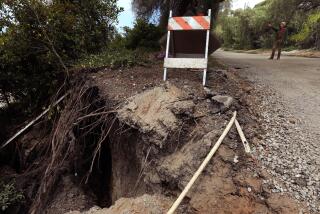Three Sisters May Get a Fourth
- Share via
BEND, Ore. — Half an hour west of this mountain town in central Oregon, in an area covered by forest, is a growing bulge in the terrain that eager scientists say could be the beginnings of a volcano.
The bulge covers 100 square miles -- roughly the size of Fresno -- and is rising at a rate of 1.4 inches a year. The shape resembles a dome, with the highest point about three miles west of the South Sister volcano in the Cascade Range.
Geologists say the bulge represents a unique opportunity to study what could be a volcanic formation in its earliest stages, but officials in this town of 65,000 worry more about the potential hazards, such as lava and ash or flying rocks.
“Is it going to blow up and bury Bend?” City Manager Harold “Andy” Anderson asked. “In the wake of [Hurricane] Katrina, we’re trying to assess our biggest natural threats, and the bulge came up in meetings as a possibility.”
Scientists have held community forums trying to assuage concerns and educate the public about why the phenomenon should inspire fascination rather than fear. They say nothing is comparable in the Cascades or possibly in all of North America, but the technology that detected the bulge is relatively new.
The bulge, in the Three Sisters Wilderness Area -- named after three volcanic peaks -- was detected in March 2001 by a geologist using a new imaging technology called radar interferometry, which uses satellites to measure changes in Earth’s surface.
Since the discovery, scientists have “wired” the bulge with additional measuring equipment. Geologists from the U.S. Geological Survey have also made annual surveying treks to the site, which is not accessible by car. A report on the latest findings -- collected in late August -- is expected this month.
Larry Chitwood, geologist for Deschutes National Forest, which encompasses the area, said the rise probably began in 1997 and has risen about a foot since. The cause of the rise is a matter of speculation.
Chitwood theorizes that a body of magma, or molten rock, could be gathering in a chamber several miles below the surface. There’s no way to know the shape of the mass, he said, but the size of the bulge indicates that it would be quite large, equivalent to a lake one mile across and 65 feet deep.
“It gives you an idea of the volume that could be involved,” Chitwood said.
He said magma could be rising at a rate of 10 feet a year. A swarm of 350 small earthquakes less than magnitude 2 rattled the interior of the bulge in March 2004, indicating that magma was in motion under the surface.
The earthquakes, in addition to last year’s series of small eruptions at Mt. St. Helens in southwest Washington, raised concern that the bulge could someday erupt -- a real possibility given the region’s history. The Cascade Range includes 14 active volcanoes, and four of them -- South Sister, Newberry, Crater Lake and Mt. Hood -- are in Oregon. South Sister, elevation 10,358 feet, last erupted about 2,000 years ago.
The bulge -- or uplift, as geologists call it -- could grow into a cinder cone, which is a hill of volcanic fragments; become a shield volcano, which has a broad, gentle slope; or remain merely a bump, according to the USGS. The most exciting prospect would be formation of “a fourth sister,” Chitwood said. “It could be a new member of the family. Every one of the peaks here had a beginning.”
If the bulge became a fourth sister, no one now living would see its final form. Chitwood said each of the Sisters took about 30,000 years “to grow up.”
On a recent sunny afternoon, a vacationer from South Africa, Francis Pulver, 27, took a break from his trek on the Pacific Crest National Scenic Trail, which runs through the area of the bulge. In a meadow between lush forests, Pulver, surveying the landscape, asked, “What is it -- a bump, a bulge? No one told me.”
The slope of the bulge is so gradual, and the terrain so rich in other natural formations such as hills and ridges, that many people don’t even know when they’re standing on top of it.
Those who’ve been led to believe that it’s “the eighth wonder of the world” will be disappointed, said Mike Schmidt, president of the Bend Chamber of Commerce. Schmidt, however, acknowledges the bulge could become another attraction.
“Sure, it could happen,” he said. “But it’ll be a long time after I’m dead.”
More to Read
Sign up for Essential California
The most important California stories and recommendations in your inbox every morning.
You may occasionally receive promotional content from the Los Angeles Times.













